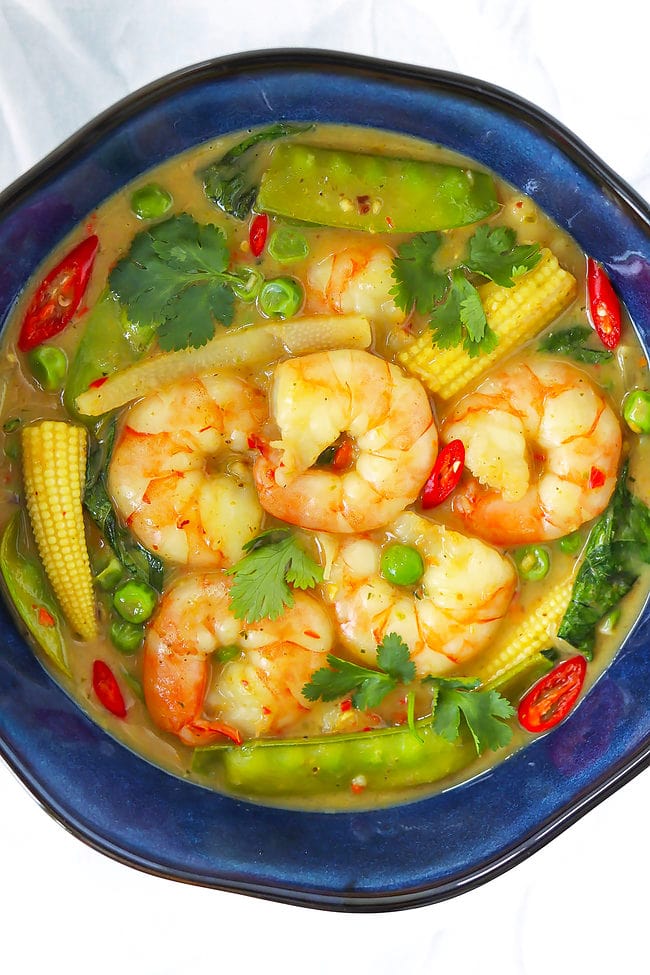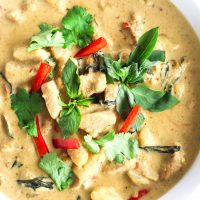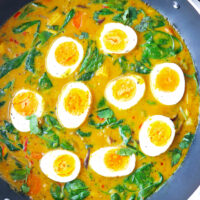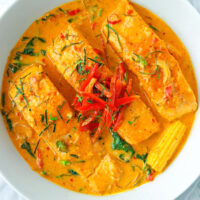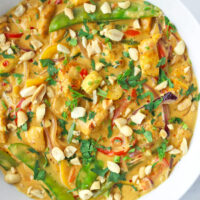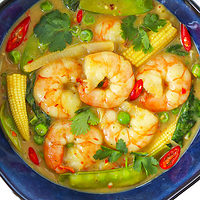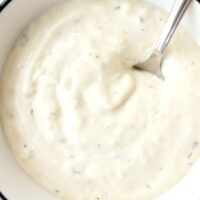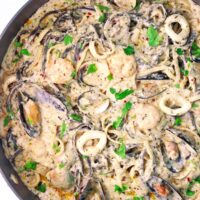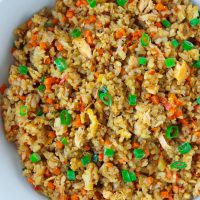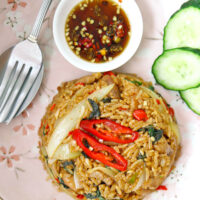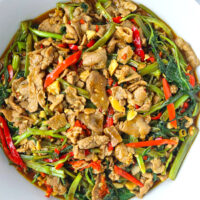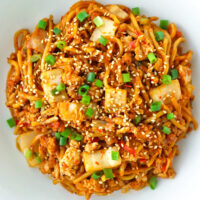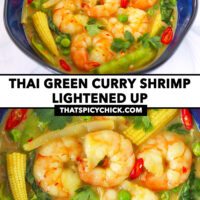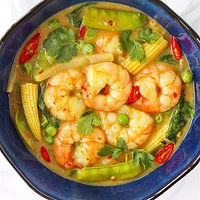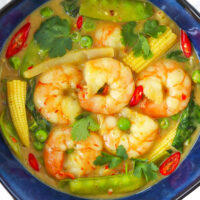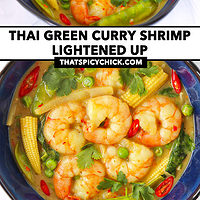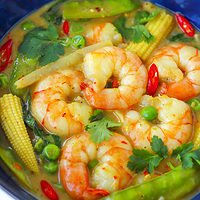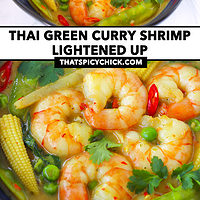Thai Green Curry Shrimp – Lightened Up
This post contains affiliate links.
Juicy shrimp, veggies, fragrant aromatics and herbs and spicy green curry paste are simmered in a lightened-up coconut milk curry in this Thai Green Curry Shrimp. It’s quick and easy to make in 35 minutes and perfect for busy weeknights!
Raise your hand if you love Thai green curry! 🙋♀️
This Thai green curry shrimp is super easy to make on any given weeknight and full of BIG flavors.
We have:
- Juicy jumbo shrimp.
- Spicy Thai green curry paste.
- Tasty aromatics and herbs. Garlic, hot fresh chilies, makrut lime leaves and intoxicatingly fragrant Thai sweet basil give this curry all the authentic flavors!
- Light coconut milk to give us a lower in calories, fat and carbs green curry sauce!
- Colorful veggies. Tender crisp baby corn, snow peas, bamboo shoots and green peas add plenty of color and crunch!
It’s ready in just 35 minutes in one wok or pot and so darn delicious!
Serve it over a bed of warm steamed brown or white rice and you have the BEST lightened-up Thai green curry shrimp meal at home!
By the way, if you’re a fan of Thai green curry, check out my Thai green curry fried rice and easy Thai green chicken curry!
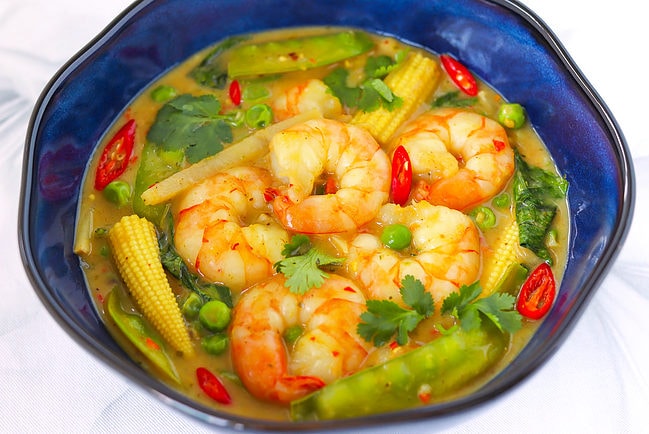
Why This Recipe Works
- Quick and easy. All you need is one wok or pan and 35 minutes to make this curry!
- Colorful and flavorful! We have plenty of tender-crisp bright veggies like snow peas, green peas, bamboo shoots and baby corn bringing color, crunch and flavor to this gorgeous curry!
- Juicy jumbo shrimp! Succulent pieces of shrimp cooked briefly in the spicy green curry at the end ensures that they retain their plump texture and do not overcook or shrink too much.
- Lightened-up. It’s lower in calories and fat since lite coconut milk is used instead of full fat coconut milk. The delicious flavors in Thai green curry are all still there!
- Thickened with corn starch. Using a corn starch slurry helps thicken the curry sauce without having to use full fat coconut milk.
- Customizable. Use your favorite protein and veggies to customize this lighter Thai green curry!
Ingredient Notes and Substitutes

- Chilies: I’ve use Thai Bird’s Eye red chilies and Prik Kee Nu green chilies, but feel free to use any small hot red and green chilies that are easily available to you. Thai Prik kee nu (<– read more about them here) green chilies are tiny, but incredibly hot. They might be difficult to track down outside of Asia so you can leave them out if unavailable. Adjust the quantity of chilies to taste based on your heat level preference.
- Asian Red Shallots: Or use red onion or regular shallots if unavailable.
- Thai Sweet Basil Leaves: Known as ‘horapa’ in Thai, this basil has a unique sweet smell and adds anise-y and herbal flavors to Thai curries like Thai green chicken curry and panang chicken curry. It’s also delicious in stir-fries like Thai green curry fried rice, Thai eggplant stir-fry, Thai eggplant noodles, and pork and tomato gravy noodles. Find it in an Asian supermarket or a Thai grocery store. Substitute with regular Italian basil leaves if unavailable.
- Bamboo Shoots: This is the tender part of the bamboo plant and it’s a vegetable that is commonly used in Thai and Chinese cuisine. I’ve used the canned version here which I finely sliced into thin strips after draining. You can also use the fresh or pre-sliced canned pickled version if they’re easily available to you. Look for it in an Asian supermarket, at a Thai grocery shop, or online (canned). If unavailable, substitute with other crunchy veggies of choice like julienned celery or sliced bell pepper.
- Coconut Sugar: Or use palm sugar, which is typically used in Thai curries. I prefer and use a Malaysian coconut sugar which is known as ‘gula kelapa’. Just like Thai palm sugar, it comes in the form of form of hardened discs. You’ll need to shave it finely using a knife so that it dissolves more easily. Feel free to swap it for granulated light brown or white sugar or a zero-calorie sweetener made with erythritol, monkfruit, or stevia.
- Makrut Lime Leaves: This Thai herb is also known as kaffir lime leaves and it has an intoxicatingly fragrant citrusy aroma. Find them in a Thai grocery store or substitute with the ground dried version which is available in most well-stocked mainstream supermarkets.
- Corn Starch Slurry (optional): Although it won’t thicken the curry and give it the same consistency as full fat coconut milk, it does help give you a slightly thickened green curry sauce. You can leave it out if you prefer as the curry will taste great without it too.
- Shrimp: Use peeled and deveined jumbo shrimp or prawns (size 16/20 preferred) for the best juicy texture. The larger the shrimp the better as they are less likely to overcook. (See ‘Variations’ section below for other protein options).
- Thai Green Curry Paste: I use Mae Ploy Thai green curry paste in my home because I find their curry pastes to be more authentic in flavor and hotter than most other brands. Maesri is another great brand if you’re looking for authentic flavor and the heat factor. For a milder curry, try De Siam or Thai Kitchen brand. Thai green curry paste can be found in large supermarkets that are well-stocked with international ingredients, Asian supermarkets and Thai grocery stores, and online.
- Lite Coconut Milk: To make this curry lighter, we’re using lite (essentially light) unsweetened coconut milk which has less fat and calories than regular full fat coconut milk. It also has a thinner consistency but still tastes like coconut milk. Find it in any mainstream supermarket or purchase it online.
- Fish Sauce: To add savory umami notes. Adjust quantity to taste based on your salt level preference. Substitute with low sodium light soy sauce if you prefer not to use fish sauce.
- Thai Chili Powder (optional): This is a blend of chili powder, flakes and seeds. You can substitute with crushed red pepper flakes or leave it out for milder flavor.
Full ingredient list and amounts are in the recipe card below.
How to Make Thai Green Curry Shrimp
1. Sauté the aromatics. Sauté the shallots, garlic, red and green chilies in a little oil in a large nonstick wok or pot until fragrant.
2. Add the veggies and curry paste. Add the snow peas, baby corn and Thai green curry paste and sauté until the veggies start to soften and the curry paste starts to break down and is fragrant.
3. Build the curry. Pour in the coconut milk and stir until the curry paste has fully integrated. Stir in the coconut sugar, finely minced makrut lime leaves, fish sauce, Thai chili powder and the corn starch slurry (if using).
4. Stir in the green peas and bamboo shoots.
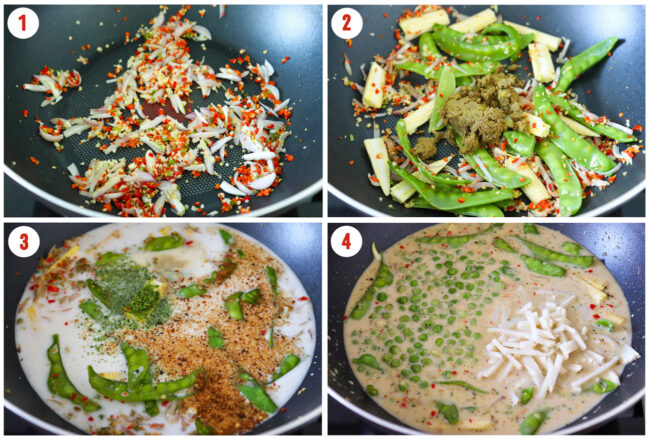
5. Add the shrimp. Cover and simmer until they’re cooked through.
6. Stir in the Thai sweet basil until just wilted. Switch off the heat.
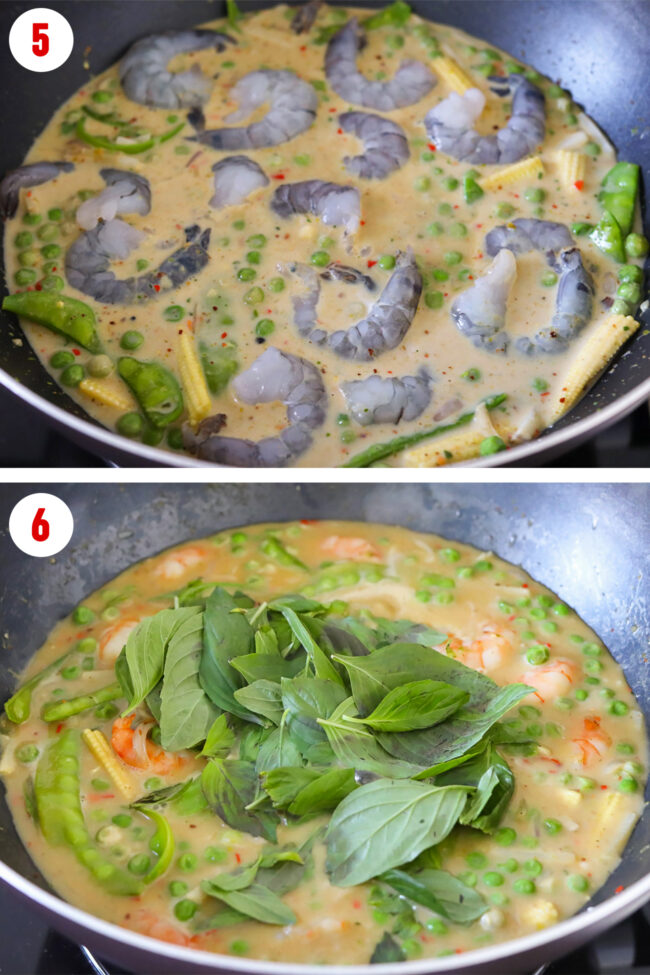
Serve! Transfer to a serving bowl and garnish with chopped coriander and sliced chili if desired. Serve immediately with warm steamed rice!
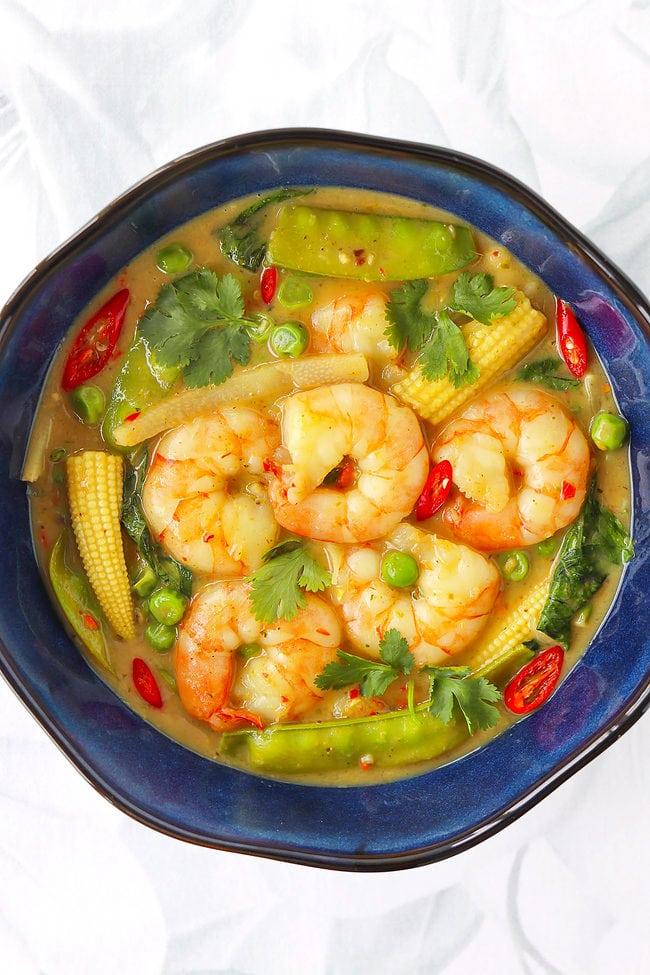
Full detailed instructions are in the recipe card below.
Cook’s Tips
- Use a lite (light or low-fat) coconut milk without many added additives in the ingredients list. The taste will be better.
- Shake the can of coconut milk well before opening it. This will ensure that the milk is fluid without any congealed bits stuck at the top or bottom of the can.
- Use coconut flour instead of corn starch in the slurry to thicken the curry. The benefit is that it will help retain the coconut flavor since coconut flour is ground coconut meat.
- Use all-purpose flour. An all-purpose flour slurry can also be used to thicken the curry.
- Double the recipe. This recipe as written yields 2 generous servings if eaten as a main without other side dishes besides rice. You can double the recipe by clicking the ‘2x’ button in the recipe card below to make 4 servings if desired.
- Serve with noodles. Serve with cooked rice noodles or zucchini noodles (low-carb option) instead of rice.

FAQs
Typically, shrimp paste is one of the ingredients in an authentic Thai green curry paste. The flavor and pungent scent are not usually discernible once the paste has been cooked in a curry or other recipe.
Yes, there are no ingredients containing gluten in Mae Ploy Thai green curry paste or this green curry shrimp recipe. However, it is best to double check the ingredients list of the green curry paste that you will purchase if you have sensitivities.
Thai green curry is the hotter than Thai red curry and yellow curry. However, the spice level is easily adjustable to make the curry milder. Simply use a little less curry paste – start with 2 teaspoons to 1 tablespoon – and don’t add extra fresh chilies of Thai chili powder to the curry.
Variations
- Add/use different veggies. Bell pepper, carrots, sugar snap peas, sweet potatoes or other waxy potatoes, button mushrooms, zucchini, broccoli or cauliflower florets, or any other type of curry friendly veggies will taste great. If using potatoes or carrots, you’ll need to simmer the curry (covered) for about 20-24 minutes or until they’re tender. You can also add pre-cooked or steamed potatoes and carrots to avoid lengthening the cook time for the curry.
- Make it with Chicken. I recommend using boneless and skinless diced chicken thighs as they’re more flavorful and don’t tend to dry out like chicken breasts in most curries. Add the chicken when you add the curry paste and mix well to combine. Stir in the coconut milk, seasonings and remaining veggies. Cover and simmer for 10-12 minutes or until the chicken is cooked through.
- Use fish. Firm white fish like cod, tilapia, ling fish, halibut, mahi mahi, etc. cut into smaller pieces can be added at the same time you’d add the shrimp.
- Make it with pork or beef. Thinly sliced pork tenderloin (fillet) or beef skirt or flank steak can also be used.
- Make it vegetarian/vegan. Use tofu, a plant-based shrimp or other plant-based meat substitute. Use a vegan Thai green curry paste which does not contain shrimp paste in the ingredients list and either a vegan fish sauce or low sodium light soy sauce.
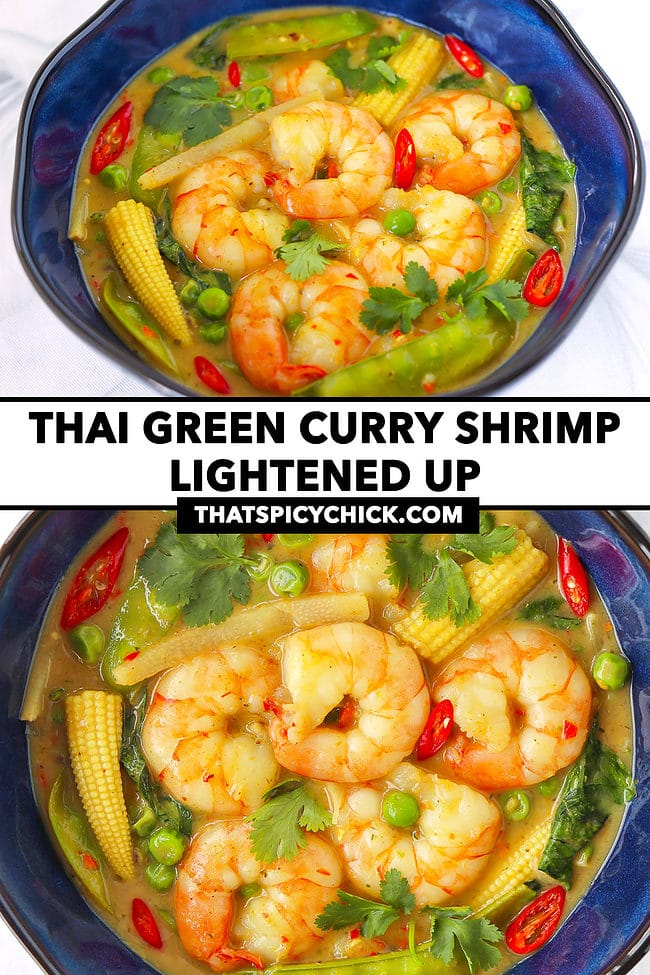
More Thai Curries
MADE THIS RECIPE? If you make this recipe, leave a comment below and let me know how you liked it! Take a photo and tag it with @thatspicychick on Instagram and hashtag it #thatspicychick and I’ll be sure to share your masterpiece!
STAY CONNECTED! You can also follow me on Pinterest, Facebook or Instagram. Sign up for my email list to get my latest recipe in your inbox weekly!
PrintThai Green Curry Shrimp – Lightened Up
Juicy shrimp, veggies, fragrant aromatics and herbs and spicy green curry paste are simmered in a lightened-up coconut milk curry in this Thai Green Curry Shrimp! Ready in 35 minutes and so delicious!
- Prep Time: 20
- Cook Time: 15
- Total Time: 35 minutes
- Yield: 2 1x
- Category: Dinner
- Method: Simmer
- Cuisine: Thai
- Diet: Gluten Free
Ingredients
- 14 grams / 4 Garlic cloves – minced
- 19 grams / 6 fresh Red Chilies (Thai Bird’s Eye or any other hot red chilies), to taste – finely chopped
- 5 grams / 5-6 Thai Green Prik Kee Nu Chilies (optional – or any other small hot green chilies – note 1), to taste – finely chopped
- 40 grams / 3 Asian Red Shallots (or use red onion or regular shallots) – peeled, finely sliced
- 15 grams / ¾ cup Thai Sweet Basil Leaves (loosely packed – note 2) – picked off stems, washed, pat-dried
- 50 grams / 3 pieces Baby Corn – hairy parts removed, sliced in half lengthwise, then again widthwise
- 75 grams / 15 pieces Snow Peas – ends trimmed, hairy parts removed
- 50 grams / ¼ cup sliced Bamboo Shoots (canned or fresh – note 3)
- 10 grams / 2 TSP Coconut Sugar (or palm sugar – note 4) – finely shaved with a knife
- 4 Makrut Lime Leaves (note 5) – destemmed, finely minced into a powder
- 100 grams / about ¾ cup frozen Green Peas
- 2 TSP Corn Starch + 1 TBLS Water – mixed together to make a slurry (optional – note 6)
- 300 grams / 10.6 ounces peeled and deveined Jumbo Shrimp (size 16/20 preferred) – washed thoroughly, pat-dried
- 7.5ml / ½ TBLS Canola Oil (or any other neutral flavored cooking oil)
- 40 grams / 2 TBLS + 2 TSP Thai Green Curry Paste (I use Mae Ploy brand – note 7)
- 400ml / 14 ounce can Lite Coconut Milk
- ¾ TBLS Fish Sauce, to taste
- ½ TSP Thai Chili Powder (optional – or use crushed red pepper), to taste
- To Serve (optional): Chopped fresh coriander (cilantro), sliced red chili (optional), warm steamed brown or white rice
Instructions
Prep:
- Prepare the ingredients: Prepare the garlic, red and green chilies, shallots, Thai sweet basil leaves, baby corn, snow peas, bamboo shoots, coconut sugar, makrut lime leaves and shrimp as indicated in the ‘ingredients’ section. Make the corn starch slurry by mixing together the corn starch and water in a small bowl until thoroughly combined
For the Thai Green Curry Shrimp:
- Sauté the aromatics: Heat ½ tablespoon of canola oil in a large nonstick wok (or pot) over medium-high heat. Add the shallots, garlic, red and green chilies and sauté for a minute until fragrant.
- Add the veggies and curry paste: Add the snow peas, baby corn and Thai green curry paste and sauté for 1-2 minutes until the veggies start to soften and the curry paste starts to break down and is fragrant.
- Build the curry: Turn the heat down to low and pour in the lite coconut milk. Stir to combine until the curry paste has fully integrated. Stir in the coconut sugar, finely minced makrut lime leaves, fish sauce, Thai chili powder (if using) and the corn starch slurry.
- Add the remaining veggies: Add the green peas and bamboo shoots. Stir to combine.
- Cook the shrimp: Turn the heat back up to medium-high and add the shrimp. Cover and simmer for 5-7 minutes or until the shrimp are no longer opaque and are cooked through.
- Stir in the basil: Stir in the Thai sweet basil leaves until just wilted – about 10-15 seconds. Switch off the heat.
- To Serve: Transfer to a serving bowl or divide servings evenly into bowls. Garnish with chopped coriander and sliced chili if desired. Serve immediately with warm steamed brown or white rice.
Notes
- Thai Prik Kee Nu Green Chilies. Thai Prik kee nu green chilies are tiny, but incredibly hot. They might be difficult to track down outside of Asia so you can leave them out if unavailable. Adjust the quantity of both red and green chilies to taste based on your heat level preference (and how hot your chilies are).
- Thai Sweet Basil Leaves. Known as ‘horapa’ in Thai, this basil has a unique sweet smell and adds anise-y and herbal flavors to Thai curries. Find it in an Asian supermarket or a Thai grocery store. Substitute with regular Italian basil leaves if unavailable.
- Bamboo Shoots. This is the tender part of the bamboo plant and it’s a vegetable that is commonly used in Thai and Chinese cuisine. I’ve used the canned version here which I sliced into thin strips after draining. You can also use the fresh or pre-sliced canned pickled version if they’re easily available to you. Look for it in an Asian supermarket, at a Thai grocery shop, or buy it online (canned). If unavailable, substitute with other crunchy veggies of choice like julienned celery or sliced bell pepper.
- Coconut Sugar. I’ve used a Malaysian coconut sugar which is known as ‘gula kelapa’. Just like Thai palm sugar, it comes in the form of form of hardened discs. You’ll need to shave it finely using a knife so that it dissolves more easily. Feel free to swap it for granulated light brown or white sugar or a zero-calorie sweetener made with erythritol, monkfruit, or stevia.
- Makrut Lime Leaves. Also known as kaffir lime leaves, these have an intoxicatingly fragrant citrusy aroma. Find them in a Thai grocery store or substitute with the ground dried version which is available in most mainstream well-stocked supermarkets.
- Corn Starch Slurry. Although it won’t thicken the curry and give it the same consistency as full fat coconut milk, it does help a give you a slightly thickened green curry sauce. You can leave it out if you prefer as the curry will taste great without it too. Alternatively, use a coconut flour (best option without sacrificing any coconut flavor) or all-purpose flour slurry to thicken the curry.
- Thai Green Curry Paste. I use Mae Ploy Thai green curry paste in my home because I find their curry pastes to be more authentic in flavor and hotter than most other brands. Maesri is another great brand if you’re looking for authentic flavor and the heat factor. For a milder curry, try De Siam or Thai Kitchen brand. Thai green curry paste can be found in large supermarkets that are well-stocked with international ingredients, Asian supermarkets and Thai grocery stores, and online.
- Double the recipe. This recipe as written will yield 2 generous servings if eaten as a main without other side dishes besides rice. You can double the recipe by clicking the ‘2x’ button at the top of the recipe card to make 4 servings if desired.
- Storing and reheating leftovers. Store leftovers in a sealed airtight container in the fridge for 2-3 days. Reheat in the microwave for 1.5-2 minutes on high or in a pot on the stovetop over medium-high heat until hot throughout.
- Nutrition information. The nutritional information provided is only for the curry without extra garnishes or a side of rice.
- See ‘Variations’ section in the post above to customize this Thai green curry.
Nutrition
- Serving Size: ½ of recipe
- Calories: 382
- Sugar: 12.3g
- Sodium: 2106.1mg
- Fat: 17g
- Saturated Fat: 15.7g
- Unsaturated Fat: 3.3g
- Trans Fat: 0g
- Carbohydrates: 22.5g
- Fiber: 9g
- Protein: 33.3g
- Cholesterol: 0mg
This post may contain affiliate links. We are a part of the Amazon Services LLC Associates Program, an affiliate advertising program designed to provide a means for us to earn a small commission (at no extra cost to you) by linking to Amazon.com and affiliated sites. The nutritional information provided is approximate and can vary based on several factors. It should only be used as a general guideline. For more information, please see our Disclosure.

